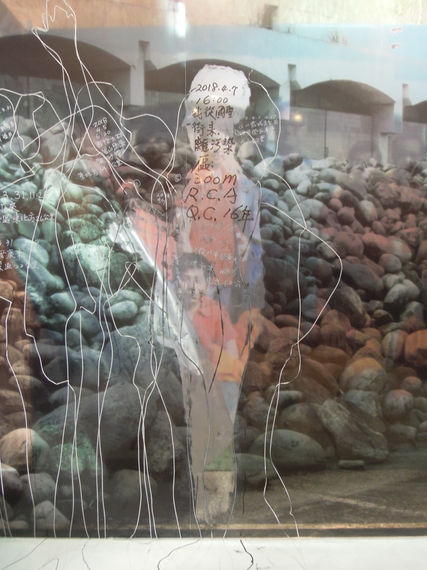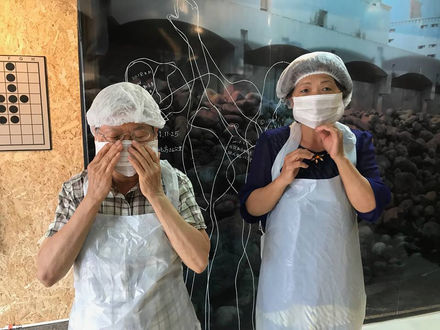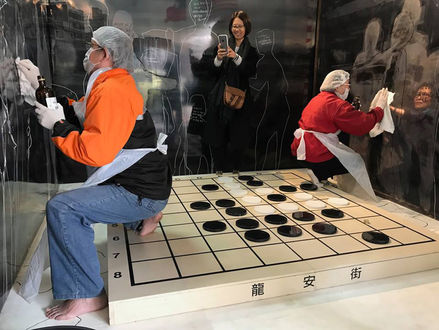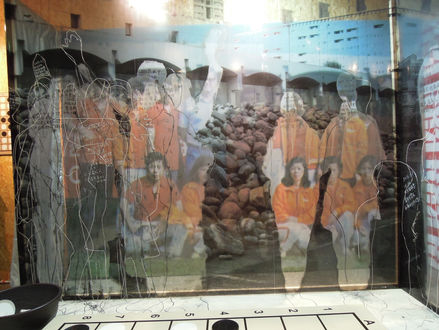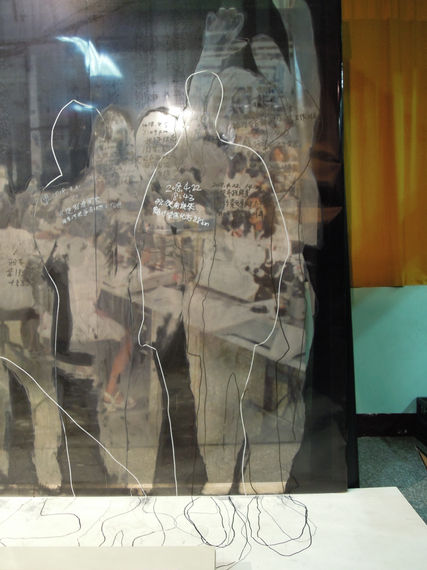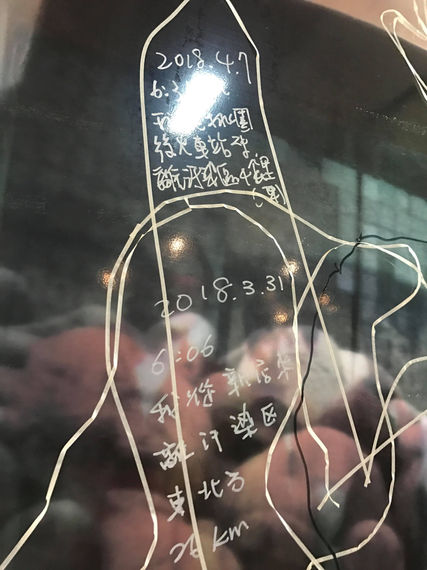What I am attempting to do with the “Reversi” projects is to provide a framework for specific sites to represent how people get involved and respond to their surroundings in the changing time-space process. The “Reversi / TaoYuan RCA Edition” show was held at the office of TAVOI (Taiwan Association for Victims of Occupational Injuries), which has worked with the RCA Self-Help Association for many years and is close to the site of the closed RCA factories. This is the first experiment in the series engaging a specific social issue. The social issue I refer to in this edition is known as “the RCA industrial pollution case in Taiwan”.
What is RCA? Learn more
What is the RCA industrial pollution case in Taiwan? Learn more
What the RCA company did in Taiwan occurred during a very specific historical time (post-cold-war), and different aspects of its influence still last today. Including the pollution and how the Taiwanese government decided the direction of its industrial development since then. The story of RCA in Taiwan not only illustrates Taiwan’s international relations throughout modern history, but it is also a symbol of the localization of “The American Dream” for the former RCA workers whose bodies are the marks left behind through this historical changing process.
Based on the RCA industrial pollution events, and without following the previous settings and rules in the other Reversi editions, I have made several adjustments in “Reversi / TaoYuan RCA Edition”. Special thanks to the TAVOI staff Nien-Yun Liou, without her assistance I would not have been able to invite several members from the RCA Self-Help Association to participate in this project. Also special thanks to all the participating members from the RCA Self-Help Association.
Reversi TaoYuan RCA Edition
Settings


When the audience enters the show space the first thing they see is an early color TV similar to a RCA TV of the 70's and 80's. Playing on the TV is footage of the Apollo 15 mission. On top of the TV is a framed article from “RCA Family” (a publication only released to company employees), detailing the contributions that RCA made to the Apollo 15 mission. The recording equipment used in this mission was made by RCA, though none of the devices were made in Taiwan.
After the Audience enters the space, they will see two layers of printouts set up around the three sides of a big game board. The inner black-and –white transparency printout shows what the three RCA factory spots looked like after the factories closed. The outer layer is composed of color images presenting the same three factory spots while the factories were in operation.

Inner Left
Inner Middle
Inner Right






Outer Left
Outer Middle
Outer Right
In this edition, the game board represents the area of the polluted underground water caused by RCA discharging the waste organic solvent into the ground.


Reversi TaoYuan RCA Edition
Rules
Black Piece:
People who have worked for RCA play black pieces
White Piece:
People who have never worked for RCA play white pieces
Every participant will have his/her body outline traced on the inner layer of the B&W transparency by the artist. The position of participant's outline depends on which direction they came from, with their outline being left on the corresponding direction on the printout. The participants who live inside of the polluted underground water area (inside of the game board) can either place their pieces on their own coordinate spot on the board (following the map) or play by regular Reversi rules. The participants who don’t live in this area have to play their pieces by Reversi rules.
Every participant can only play one piece a day. Participants can come back to play a new piece every day.
The whole process of each participant’s interaction was streamed on live video on a Facebook event page. After the participant has finished placing the piece, the artist will interview them asking what his/her strategies to make this move were. The interviews were streamed on FB live video as well, and also played live on the color TV at the entrance.
Black Pieces:
People who worked for RCA
The black piece players pose in a position related to their job at RCA and the artist draws an outline of them with a black pen. Then the black piece players will write down Where they live, Which direction, and How far they live from the polluted water area / Their position at RCA / and The duration they worked for RCA, inside of their outlines. Then the participant places one black piece on the board, sees how many more new black pieces have appeared after the move, and picks up an equal amount of RCA-related objects prepared by the artist, and hides an object under each new-gained black piece.
After one black piece is placed, it will lead to one of 2 situations in the game:
1. If after the move the amount of all the black pieces on the board are less than or equal to the amount of all the white pieces on the board:
The black body outlines they just left remain the same.
2. If after the move the amount of all the black pieces on the board are more than the amount of all the white pieces on the board:
The black piece player will put on a “clean room suit costume” (similar to the clean room suits they put on when they were working at RCA to protect the equipment, but not the workers’ health), wet a rag with a bottle of heavy concentration ethyl alcohol (a kind of organic solvent that doesn’t harm the body), and wipe/clean out the B&W printout image inside of their body outline (cleaning was the activity when they were using the organic solvent that polluted the environment and damaged the worker's health). When it is done, others can see part of the outer color printout (when RCA factories still functioned well in Taiwan, “The Good Old Time”) through the previous RCA workers’ body outline. The dirty rags used by each black piece player for cleaning are then marked with the player/workers name and hung on the wall in the “Rag Section”.
White Pieces:
People who never worked for RCA
The white piece players will pose in a random gesture and the artist will use thin white tape to outline their body. After that the white piece player writes down Where they live/ Which direction and How far they live from the polluted underground water area. Then the participant places one white piece on the board, and removes the black pieces replaced by white ones along with the RCA-related objects hidden underneath.
After finishing the above steps, the artist will interview both black and white piece players in front of a Reversi model in the “Interview Section”. The players will use the model to explain their strategies, and to also leave advice about how to play the next move to future players who might see the video on the FB event page. The black piece players have to explain why they chose certain RCA related objects and tell the audience what kind of narratives they want to leave through these objects/fragments. The white piece players have to interpret the objects/fragments they found under the black pieces and tell the audience what kind of information they have learned through these objects/fragments.
The first completed game finished on the afternoon of Apr. 22nd, the score was 44 (black): 20 (white), with the black piece players/RCA previous worker team winning. The original idea was that after finishing a completed game we would start a whole new game, however after talking to TAVOI staff Nien-yun and my assistant Xing-duan, we decided to apply different rules for the next game. Xing-duan proposed an excellent idea that instead of starting a game as it is supposed to be started (in regular Reversi rules when a game is restarted there are only 2 pieces of each color left on the board), we would leave the 44 black pieces from the previous game, and only reset 2 white pieces on the board to start a new game. Besides this adjustment, the other new rule is only white piece players (Non RCA staff) could make moves in this new game. Based on the score from the last game, the black team was way ahead of the white team, but without making any move in the new game, the black piece players could only watch the white piece players playing the game.
Why did we decide to change the rules like this?
In this process we talked a lot about the dialectical relations between black and white pieces. Such as the white piece players don’t always try to help their own team, the players from different camps are not always against each other, and if it is a good thing that the black pieces occupied every space on the board. The key point is, as a representation of RCA workers in the game, the members of the black team need to figure out how to work with the white team to let the game continue. Doing that causes a possibility for the white piece players to realize the RCA story isn’t just about the others, but that they themselves are involved and connected to the RCA pollution case in a deeper way than they thought. The location I chose for the project is very beneficial for the black team to win the game, but besides “winning the game” what kind of legacy did the RCA pollution case leave behind to people afterward? As time goes by, the number of black team members/RCA previous workers will be less and less. When they have all disappeared in the world will the white team members/non RCA worker recognize the legacy they left behind, inherit it, and pass it on? These discussions and thoughts pointing to the future contribute to the motivation about changing the rules to restart a game.
In “Reversi / TaoYuan RCA Edition” by participating in the game the members of the RCA Self-Help Association rebuild and re-perform a narrative intersected with stories about industry development, pollution, and changes to the landscape. For the participants who never worked at RCA, they explore a new perception and connection through the narrative. As a real social event involved in the Reversi serial, the RCA pollution case brings a lot of effective and profound conversations and performance to this project. The Reversi game also provides this social issue an alternative space to be interpreted beyond the mainstream and political-correctness.



